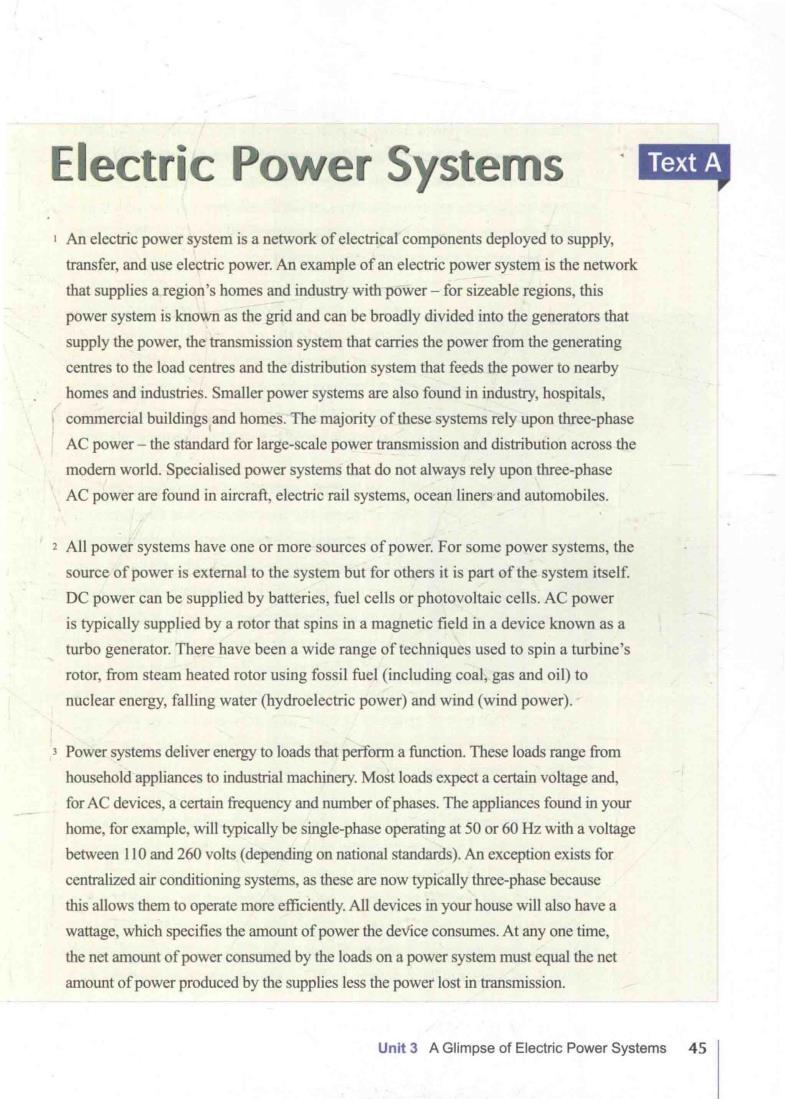正在加载图片...

Electric Power Systems Text A An electric power system is a network of electrical components deployed to supply. transfer,and use electric power.An example of an electric power system is the network that supplies a region's homes and industry with power-for sizeable regions,this power system is known as the grid and can be broadly divided into the generators that supply the power,the transmission system that carries the power from the generating centres to the load centres and the distribution system that feeds the power to nearby homes and industries.Smaller power systems are also found in industry,hospitals, commercial buildings and homes.The majority of these systems rely upon three-phase AC power-the standard for large-scale power transmission and distribution across the modem world.Specialised power systems that do not always rely upon three-phase AC power are found in aircraft,electric rail systems,ocean liners and automobiles 2 All power systems have one or more sources of power.For some power systems,the source of power is external to the system but for others it is part of the system itself. DC power can be supplied by batteries,fuel cells or photovoltaic cells.AC power is typically supplied by a rotor that spins in a magnetic field in a device known as a turbo generator.There have been a wide range of techniques used to spin a turbine's rotor,from steam heated rotor using fossil fuel (including coal,gas and oil)to nuclear energy,falling water(hydroelectric power)and wind(wind power). Power systems deliver energy to loads that perform a function.These loads range from household appliances to industrial machinery.Most loads expect acerain voltage and, forACdevicesern frequency and number of phases The appiances found inyour home,for example,will typically be single-phase operating at 50 or 60 Hz with a voltage between 110 and 260 volts(depending on national standards).An exception exists for centralized air conditioning systems,as these are now typically three-phase because thisallows themtooperate more efficeyAll devicesnyououse will alsohavea wattage,which specifies the amount of power the device consumes.At any one time, the net amount of power consumed by the loads on a power system must equal the net amount of power produced by the supplies less the power lost in transmission Unit 3 A Glimpse of Electric Power Systems 45Electri .c Power Systems 1 An electric power system is a network of electrical components deployed to supply, transfer, and use electric power. An example of an electric power system is the network that supplies a region's homes and industry with -power - for sizeable regions, this power system is known as the grid and can be broadly divided into the generators that supply the power, the transmission system that carries the power from the generating centres to the load centres and the distribution system that feeds the power co nearby homes and industries. Smaller power systems are also found in industry, hospitals, , commercial buildings .and homes. The majority of these systems rely upon three-phase AC power - the standard for large-scale power transmission and distribution across the modern world. Specialised power stems that do not always rely upon three-phase AC power are found in aircraft, electric rail systems, ocean liners and automobiles. 2 All power systems have one or more sources of power. For some power systems, the source of power is external to the system but for others it is part of the system itself. DC power can be supplied by batteries, fuel cells or photovoltaic cells. AC power is typically supplied by a rotor that spins in a magnetic field in a device known as a turbo generator. There have been a wide range of techniques used to spin a turbine's rotor, from steam heated rotor using fossil fuel (inclu coal, gas and oil) to nuclear energy, falling water(hydroelectric power) and wind (wind power). J Power systems deliver energy to loads that perform a function. These loads range from household appliances to industrial machinery. Most loads expect a certain voltage and, for AC devices, a certain frequency and number of phases. The appliances found in your home, for example, will typically be single-phase opera at 50 or 60 Hz with a voltage between 110 and 260 volts (depending on national standards). An exception exists for centra ed con tioning systems, as these are now typically three-phase because allows them to operate more efficiently. All devices in your house will also have a wattage, which speci:fies the amount of power the device consumes. At any one time, the net amount of power conswned by the loads on a power system must equal the net amount of power produced by the supplies less the power lost in transmission. Unit 3 A Glimpse of Electric Power Systems 45